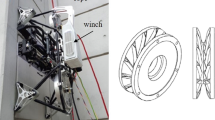Abstract
Wall attachment mechanisms for robot have attracted great attention. In this study, we present a novel fabrication method for flexible micro-pin array adapting to various surface profiles. The fabrication process was composed of three steps. First, the stainless steel (AISI304) micro-pin array was fabricated by using laser beam machining. In this process, laser beam machining was adopted because it is valuable for machining stainless steel. Dross and recast layers that were generated during laser machining were used as a material of micro-pin. Second, to eliminate unnecessary area without micro-pin, electrochemical etching was carried out. In this step, paraffin wax was coated to protect micro-pin array. It was eliminated by using heat and ultrasonic wave vibration after finishing electrochemical etching. Lastly, Polydimethylsiloxane (PDMS) as a flexible base was formed to etched micro-pin array. As a result, flexible based micro-pin array was fabricated. To verify attachment application on the wall, interlocking force between flexible micro-pin array and curved rough surface was measured (39.71 mN).















Similar content being viewed by others
Reference
Asbeck, A. T., Kim, S., Cutkosky, M. R., Procancher, W. R., & Lanzetta, M. (2006). Scaling hard vertical surfaces with compliant microspine arrays. International Journal of Robotics Research,25, 1165–1179.
Dai, Z. D., Gorb, S. N., & Schwarz, U. (2002). Roughness-dependent friction force of the tarsal claw system in the beetle Pachnoda marginata (Coleoptera, Scarabaeidae). The Journal of Experimental Biology,205, 2479–2488.
Kim, S. B., Asbeck, A. T., Cutkosky, M. R., & Provancher, W. R. (2005). SpinybotII: Climbing hard walls with compliant microspines. Advanced Robotics,12, 18–20.
Park, J. H., Allen, M. G., & Prausnitz, M. R. (2005). Biodegradable polymer microneedles: Fabrication, mechanics and transdermal drug delivery. Journal of Controlled Release,104, 51–66.
Lee, S. W., Shin, H. S., & Chu, C. N. (2013). Fabrication of micro-pin array with high aspect ratio on stainless steel using nanosecond laser beam machining. Applied Surface Science,264, 653–663.
Sivamani, R. K., Liepmann, D., & Maibach, H. I. (2007). Microneedles and transdermal application. Expert Opinion on Drug Delivery,4(1), 19–25.
Starikov, D., Boney, C., Pillai, R., Bensaoula, A., & Simakin, G. A. (2004). Spectral and surface analysis of heated micro-column arrays fabricated by laser-assisted surface modification. Infrared Physics and Technology,45, 159–167.
Huang, M., Zhao, F., Cheng, Y., Xu, N., & Xu, Z. (2008). Large area uniform nanostructures fabricated by direct femtosecond laser ablation. Optics Express,16(23), 19354–19365.
Noda, K., Hashimoto, Y., Tanaka, Y., & Shimoyama, I. (2009). MEMS on robot applications. In Solid-state sensors, actuators and microsystems conference (pp. 2176–2181).
Bhagat, A. A. S., Jothimuthu, P., & Papautsky, I. (2007). Photodefinable polydimethylsiloxane (PDMS) for rapid lab-on-a chip prototyping. Lab on a Chip,7, 1192–1197.
Menon, C., Murphy, M., & Sitti, M. (2004). Gecko inspired surface climbing robots. In International conference on robotics and biomimetics (pp. 22–26).
Bodas, D., & Malek, C. K. (2006). Formation of more stable hydrophilic surface of PDMS by plasma and chemical treatments. Microelectronic Engineering,83, 1277–1279.
Sia, S. K., & Whitesides, G. M. (2003). Microfluidic devices fabricated in poly(dimethylsiloxane) for biological studies. Electrophoresis,24, 3563–3576.
Eve, S., & Mohr, J. (2009). Study of the surface modification of the PMMA by UV-radiation. Procedia Engineering,1, 237–240.
Pangule, R. C., Banerjee, I., & Sharma, A. (2008). Adhesion induced mesoscale instability patterns in thin PDMS-metal bilayers. The Journal of Chemical Physics,128, 234708.
Riverio, A., Quintero, F., Lusquinos, F., Comesana, R., & Pou, J. (2011). Study of melt flow dynamics and influence on quality for CO2 laser fusion cutting. Journal of Physics D: Applied Physics,44, 135501.
Tani, G., Tomesani, L., Campana, G., & Fortunato, A. (2004). Quality factors assessed by analytical modeling in laser cutting. Thin Solid Film,453–454, 486–491.
Yilbas, B. S., & Aleem, B. J. A. (2006). Dross formation during laser cutting process. Journal of Physics D: Applied Physics,39, 1451–1461.
Acknowledgements
This work was supported by the National Research Foundation of Korea(NRF) grant funded by the Korea government(MSIT) (No. 2019R1F1A1056012).
Author information
Authors and Affiliations
Corresponding author
Additional information
Publisher's Note
Springer Nature remains neutral with regard to jurisdictional claims in published maps and institutional affiliations.
Rights and permissions
About this article
Cite this article
Park, J.W. Fabrication of Flexible Base Micro-pin Array and Wall Attachment Application. Int. J. Precis. Eng. Manuf. 21, 787–795 (2020). https://doi.org/10.1007/s12541-019-00302-x
Received:
Revised:
Accepted:
Published:
Issue Date:
DOI: https://doi.org/10.1007/s12541-019-00302-x




